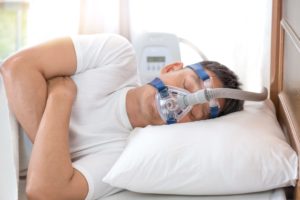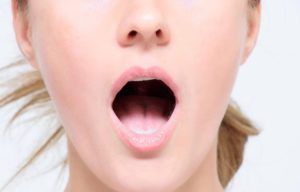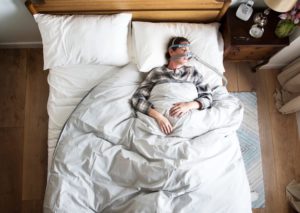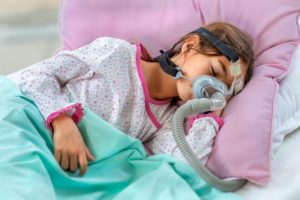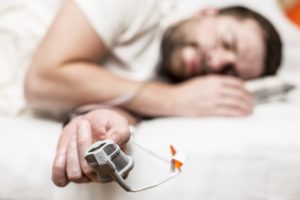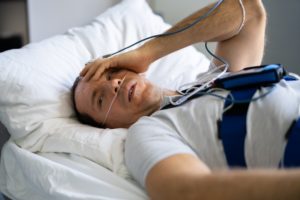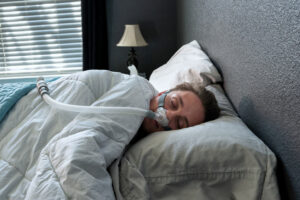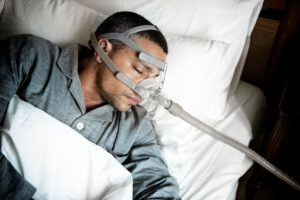When you buy through our links, we may earn a commission. Products or services may be offered by an affiliated entity. Learn more.
Chiari Malformations and Sleep Apnea
Chiari malformations are physical irregularities in the place where the brain meets the spine. People with a Chiari malformation often have accompanying sleep apnea, which is a disorder characterized by gaps in breathing that disrupt a person’s sleep. Sometimes sleep apnea is the primary symptom indicating an underlying Chiari malformation, and other times sleep apnea symptoms appear after a surgical procedure to correct Chiari malformation.
Experiencing sleep-disordered breathing doesn’t usually suggest that a person has Chiari malformation. Obstructive sleep apnea (OSA) is extremely prevalent in the general public, occurring in up to 38% of people. By contrast, it is estimated that only 0.5% to 3.5% of the population has a Chiari malformation. However, for those with a Chiari malformation, it can be useful to know that sleep apnea is a possible side effect.
What Are Chiari Malformations?
The term Chiari malformations refers to a collection of physical irregularities in the area where the brain meets the spinal cord. Generally, these malformations cause the brain to protrude beyond the base of the skull and enter the spinal canal . This atypical brain placement can put excessive pressure on the brain and interrupt the flow of cerebrospinal fluid to and from the brain.
Chiari malformations get their name from Hans Chiari , the medical researcher who first discovered this type of malformation in 1891. Since Julius Arnold , another researcher, greatly added to our understanding of these conditions, they are also referred to as Arnold-Chiari malformations.
Think You May Have Sleep Apnea? Get Help Today

our partner at sleepdoctor.com
10% off Home Sleep Tests
Buy Now“Truly grateful for this home sleep test. Fair pricing and improved my sleep!”
Dawn G. – Verified Tester
Symptoms
Symptoms of Chiari malformations vary widely from person to person, with some people displaying no symptoms at all. Common symptoms include:
- Neck pain
- Vision problems
- Vertigo and dizziness
- Hearing loss
- Headaches in the base of the skull, sometimes made worse by coughing or sneezing
Some people with a Chiari malformation also experience fainting episodes, fatigue, or unpleasant sensations in the hands and feet such as pain, numbness, or weakness. The pressure a Chiari malformation causes can also lead to a fluid-filled cyst in the spinal cord, called a syrinx. A syrinx in the spine may cause its own symptoms due to its effects on the nervous system.
Causes
Chiari malformations arise because part of the skull is too small , which forces the brain and spinal cord to make unnatural adaptations. These problems are likely present from birth for most people with Chiari malformations, although the effects may not be noticeable until years later. Recent research identifying specific gene mutations common in people with Chiari I malformation supports the hypothesis that Chiari malformations have a genetic component.
More rarely, a person is not born with a Chiari malformation, but develops a Chiari malformation during life. Health issues that cause pressure buildup in the skull, such as a tumor or fluid in the brain, can prompt a Chiari malformation. Certain treatments for other disorders, such as draining cerebrospinal fluid through a shunt or taking a high dose of growth hormone , have also been linked to the development of a Chiari malformation.
Types
Currently there are three commonly accepted types of Chiari malformations, as well as several more that are still under debate. Chiari malformation type I is the most common. Different types of Chiari malformations are associated with different levels of severity, both in physical terms and with regards to the symptoms experienced:
- Chiari Malformation Type I: In Chiari I malformation, the cavity at the back of the brain is smaller than normal, causing a part of the brain called the cerebellar tonsils to be pushed down through the hole at the base of the skull. This causes pressure buildup at the top of the spinal cord and impedes the flow of cerebrospinal fluid, potentially causing syrinxes. Many people with this type of Chiari malformation do not have symptoms at all, or do not experience symptoms until they are teenagers or adults.
- Chiari Malformation Type II: In Chiari type II , the cerebellar tonsils as well as several other parts of the brain descend into the spinal canal. People with this type of Chiari malformation tend to have more severe symptoms, such as an accumulation of fluid in the brain. Chiari type II is often associated with another condition called spina bifida, which is a birth defect that causes the spinal cord to remain exposed. Most people with Chiari II malformation require surgery as an infant or child to close the open spinal cord and relieve pressure at the base of the brain.
- Chiari Malformation Type III: This type of malformation is even more severe and less common than Chiari types I and II. In Chiari III, part of the brain descends into an exterior fluid-filled sac instead of into the spinal cord. This is often detected before or during birth. It requires surgery to remove the protruding brain tissue, drain extra cerebrospinal fluid, and patch up the skull, if possible.
Some controversial types of Chiari malformations include IV, 0, 1.5, and V:
- Chiari Malformation Type IV: In Chiari type IV, the brain does not fully develop. Some experts do not consider this malformation a true form of Chiari because it does not always involve the brain protruding downward toward the spine, as is common with the other types.
- Chiari Malformation Type 0: For people with Chiari type 0, the lower brain does not protrude toward the spine, but the person may have syrinxes in the spinal cord as with other types of Chiari malformations.
- Chiari Malformation Type 1.5: Some experts argue that when a greater amount of the cerebellar tonsils and the brainstem are pushed down into the spinal cord, this should be considered Chiari 1.5 instead of Chiari I.
- Chiari Malformation Type V: The proposed classification of Chiari V would be reserved for people who do not develop a cerebellum, and in whom other areas of the brain descend down through the base of the skull.
Chiari Malformations and Sleep Apnea
Research suggests sleep-disordered breathing occurs in as many as 70% or even 88% of people with Chiari I malformation. In multiple cases, sleep apnea is the primary or even the only symptom of Chiari malformation I a person experiences.
People with Chiari malformations may experience obstructive sleep apnea (OSA), central sleep apnea (CSA), or a mix of obstructive and central sleep apnea. OSA causes pauses in breathing during sleep due to the airway being physically blocked . In central sleep apnea, pauses in breathing result from a lack of signaling from the brainstem. Compression of the brainstem due to Chiari malformations can affect the nerves that control breathing, contributing to central sleep apnea. On a physical level, Chiari malformations can also cause muscle weakness in the throat and contribute to obstructive sleep apnea.
A study of children with Chiari I malformation found that the farther the brain protrudes downward into the spinal canal, the more likely a person is to have OSA. Researchers have also connected factors such as syrinxes, fluid in the brain, and displacement of cerebrospinal fluid to sleep-disordered breathing in people with Chiari malformations.
Some researchers hypothesize that Chiari I malformation might become symptomatic during childhood in more people than originally thought, especially in children younger than 3 years old . Experts urge doctors to incorporate testing for sleep-disordered breathing when treating people for Chiari malformations. Likewise, doctors should consider the possibility that a child might have an undiagnosed Chiari malformation if they are experiencing sleep apnea for seemingly no reason.
Treatment Options for Sleep Apnea With Chiari Malformations
The most common treatment for a Chiari malformation that causes symptoms is decompression surgery. Decompression surgery involves reducing pressure on the brain and spinal cord, usually by removing a small portion of the skull in order to create more space for the brain. Sometimes other parts of bone or brain are removed as well, or a tube called a shunt is used to remove cerebrospinal fluid and ease pressure buildup.
In people who have Chiari I malformation and sleep-disordered breathing, nearly 80% show an improvement in or resolution of apnea symptoms after decompression surgery. Surgery has also been shown to relieve sleep apnea symptoms for people with Chiari II malformation .
For individuals with Chiari malformation who continue to experience sleep apnea even after surgery, two common treatments are used, depending on the type of sleep apnea:
- Continuous Positive Airway Pressure (CPAP): CPAP therapy is generally the first line of treatment for OSA, and it has been successfully used to improve OSA symptoms in some people with Chiari malformations. A CPAP machine pushes air into a person’s airway through a mask while they sleep to keep the airway open. While effective for OSA, CPAP therapy may not work for people who also experience central sleep apneas .
- Adaptive Servo Ventilation (ASV): ASV therapy has been used to successfully treat people who have Chiari I malformation and CSA both pre-surgery and post-surgery . An ASV machine operates similarly to a CPAP machine, by pushing air into a person’s airway through a mask. However, an ASV machine is appropriate for both CSA and OSA as it can identify CSA-related breathing patterns and change its pressure accordingly.
When to Talk to Your Doctor
Talk to your doctor if you experience telltale signs of sleep apnea such as snoring, lapses in breathing, or gasping for air while you sleep. The disorder may also cause excessive tiredness during the day and morning headaches. Identifying and treating sleep apnea is important, since sleep apnea increases the risk of developing other health problems and impacts quality of life.
You should also consult a healthcare provider if you have symptoms that are compatible with Chiari malformations. Your doctor can ask questions, order relevant tests, and determine a treatment plan.

Still have questions? Ask our community!
Join our Sleep Care Community — a trusted hub of sleep health professionals, product specialists, and people just like you. Whether you need expert sleep advice for your insomnia or you’re searching for the perfect mattress, we’ve got you covered. Get personalized guidance from the experts who know sleep best.
References
18 Sources
-
MedlinePlus: National Library of Medicine (US). (2019, May 14). Chiari malformation., Retrieved September 9, 2021, from
https://medlineplus.gov/chiarimalformation.html -
McClugage, S. G., & Oakes, W. J. (2019). The Chiari I malformation. Journal of Neurosurgery: Pediatrics, 24(3), 217–226.
https://pubmed.ncbi.nlm.nih.gov/31473667/ -
Kular, S., & Cascella, M. (2021). Chiari I malformation. In StatPearls. StatPearls Publishing.
https://pubmed.ncbi.nlm.nih.gov/32119496/ -
Aitken, L. A., Lindan, C. E., Sidney, S., Gupta, N., Barkovich, A. J., Sorel, M., & Wu, Y. W. (2009). Chiari type I malformation in a pediatric population. Pediatric Neurology, 40(6), 449–454.
https://pubmed.ncbi.nlm.nih.gov/19433279/ -
Sadler, B., Wilborn, J., Antunes, L., Kuensting, T., Hale, A. T., Gannon, S. R., McCall, K., Cruchaga, C., Harms, M., Voisin, N., Reymond, A., Cappuccio, G., Brunetti-Pierri, N., Tartaglia, M., Niceta, M., Leoni, C., Zampino, G., Ashley-Koch, A., Urbizu, A., … & Haller, G. (2021). Rare and de novo coding variants in chromodomain genes in Chiari I malformation. American Journal of Human Genetics, 108(1), 100–114.
https://pubmed.ncbi.nlm.nih.gov/33352116/ -
Mori, T., Nishino, E., Jitsukawa, T., Hoshino, E., Hirakawa, S., Kuroiwa, Y., Fuse, S., Yoto, Y., & Tsutsumi, H. (2018). Chiari type 1 malformation associated with central sleep apnea after high dose growth hormone (GH) therapy in a 12-year-old boy: A case report. Clinical Pediatric Endocrinology: Case Reports and Clinical Investigations: Official Journal of the Japanese Society for Pediatric Endocrinology, 27(1), 45–51.
https://pubmed.ncbi.nlm.nih.gov/29403156/ -
Kuhn, J., & Emmady, P. D. (2021). Chiari II malformation. In StatPearls. StatPearls Publishing.
https://pubmed.ncbi.nlm.nih.gov/32491430/ -
Amin, R., Sayal, P., Sayal, A., Massicote, C., Pham, R., Al-Saleh, S., Drake, J., & Narang, I. (2015). The association between sleep-disordered breathing and magnetic resonance imaging findings in a pediatric cohort with Chiari 1 malformation. Canadian Respiratory Journal, 22(1), 31–36.
https://pubmed.ncbi.nlm.nih.gov/25379655/ -
St Louis, E. K., Jinnur, P., McCarter, S. J., Duwell, E. J., Benarroch, E. E., Kentarci, K., Pichelmann, M. A., Silber, M. H., Boeve, B. F., Olson, E. J., Morgenthaler, T. I., & Somers, V. K. (2014). Chiari 1 malformation presenting as central sleep apnea during pregnancy: A case report, treatment considerations, and review of the literature. Frontiers in Neurology, 5, 195.
https://pubmed.ncbi.nlm.nih.gov/25386156/ -
Leu, R. M. (2015). Sleep-related breathing disorders and the Chiari 1 malformation. Chest, 148(5), 1346–1352.
https://pubmed.ncbi.nlm.nih.gov/26158759/ -
Strohl, K. P. (2019, March). Merck Manual Consumer Version: Sleep Apnea., Retrieved September 8, 2021, from
https://www.merckmanuals.com/home/lung-and-airway-disorders/sleep-apnea/sleep-apnea -
Ciaramitaro, P., Ferraris, M., Massaro, F., & Garbossa, D. (2019). Clinical diagnosis-part 1: What is really caused by Chiari I. Child’s Nervous System: CnHS: Official Journal of the International Society for Pediatric Neurosurgery, 35(10), 1673-1670.
https://pubmed.ncbi.nlm.nih.gov/31161267/ -
Abel, F., & Tahir, M. Z. (2019). Role of sleep study in children with Chiari malformation and sleep disordered breathing. Child’s Nervous System: CnHS: Official Journal of the International Society for Pediatric Neurosurgery, 35(10), 1763–1768.
https://pubmed.ncbi.nlm.nih.gov/31372737/ -
Luigetti, M. Losurdo, A., Dittoni, S., Testani, E., Colicchoi, S., Gnoni, V., Farina, B., Scarano, E., Zampino, G., Mariotti, P., Rendeli, C., Di Rocco, C., Massimi, L., & Della Marca, G. (2010). Improvement of obstructive sleep apneas caused by hydrocephalus associated with Chiari malformation type II following surgery. Journal of Neurosurgery Pediatrics, 6(4), 336–339.
https://pubmed.ncbi.nlm.nih.gov/20887105/ -
Strohl, Kingman P. (2020, Sept). Obstructive Sleep Apnea. Merck Manual Professional Version., Retrieved September 9, 2021, from
https://www.msdmanuals.com/professional/pulmonary-disorders/sleep-apnea/obstructive-sleep-apnea -
Poca, M. A., Ferré, A., de la Calzada, M. D., Moncho, D., Fernandez-Torrelles, S., & Sahuquillo, J. (2021). CO2-induced intracranial hypertension and high-amplitude B-waves in a patient with Chiari 1 malformation and sleep apnea syndrome that resolved following CPAP therapy. Acta Neurochirurgica, 10.1007/s00701-021-04717-2. Advance online publication.
https://pubmed.ncbi.nlm.nih.gov/33528722/ -
Yosunkaya, S., & Pekcan, S. (2013). Complex sleep apnea syndrome in a child with Chiari malformation type 1. The Turkish Journal of Pediatrics, 55(1), 107–111.
https://pubmed.ncbi.nlm.nih.gov/23692844/ -
Fahim, A., & Johnson, A. O. (2012). Chiari malformation and central sleep apnoea: Successful therapy with adaptive pressure support servo-ventilation following surgical treatment. BMJ Case Reports, 2012.
https://pubmed.ncbi.nlm.nih.gov/23097576/


























